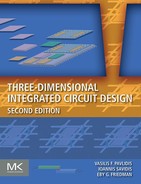Extension of the Proposed Model to Include Variations of Wires
The model described in Section 17.2 can be extended to include variations in the horizontal wires. This extended model is presented in this appendix. Consider the 3-D clock tree shown in Fig. 17.8, where the delay variations of a buffer stage Δdstage(i) include the variations due to the capacitance ΔCint and resistance ΔRint of the wires,
(F.1)
 (F.1)
(F.1)
According to the definition of ![]() in (17.24), the term
in (17.24), the term ![]() is included in Δdi+1. Consequently, Δdstage(i) is rewritten as
is included in Δdi+1. Consequently, Δdstage(i) is rewritten as
(F.2)
 (F.2)
(F.2)
where delay variations due to the wires are denoted by Δdint(i).
As discussed in [637], since the variations of the characteristics of the metal wires are relatively low as compared with nominal values, the variations of the wire delay can be approximated by a first order Taylor series expansion without significant loss of accuracy. Similar to (17.26), Δdint(i) can be approximated as
(F.3)
 (F.3)
(F.3)
where pj is the jth parameter of the wire, and P is the vector of the parameters of those wires affected by process variations. For example, consider the variations in the width and thickness of the metal and the thickness of the ILD [637,638], P(Wint, hint, tILD). Assuming these parameters are modeled by a Gaussian distribution and are independent of each other [637], the distribution of Δdint(i) can be approximated by a Gaussian distribution,
(F.4)
(F.5)
 (F.5)
(F.5)
(F.6)
(F.7)
where ρ, l, hint, and Wint are, respectively, the resistivity, length, thickness, and width of the interconnect, Cg includes both the ground and fringe capacitance, and Cc is the coupling capacitance. Expressions of Cg and Cc are available, respectively, in [252] and [766].
Considering the delay variations caused by both the clock buffers and wires in (F.2), the skew variations Δsu,v includes two terms,
(F.8)
The distribution of Δsb(u,v) is obtained from (17.24)–(17.45). The distribution of Δsint(u,v) is obtained from (17.30)–(17.45) by substituting Δdint(i) for Δdi. Consequently, Δsu,v can be described by a Gaussian distribution,
(F.9)
The extended model is compared with Monte Carlo simulations including the variations of rint and cint in a π interconnect model. Based on the parameters in [637], the nominal value and standard deviation of the parameters of the wires are listed in Table F.1. The multi-via and single via trees described in Section 17.2 are used to verify the accuracy of the extended model. The results for the independent WID variations are reported in Table F.2, where the accuracy of the model including variations in the wires is reasonably high (<8% for a multi-via clock network topology).
Table F.1
Parameters of the Horizontal Interconnects
| Parameters | Wm [nm] | tm [nm] | tILD [nm] |
| Nominal | 430 | 1000 | 160 |
| 3σD2D | 43 | 50 | 12 |
| 3σWID | 21.5 | 25 | 6 |

Table F.2
Skew Variation in 3-D Circuits Considering Wire Variations
| Topology | Multi-via Topology | Single-via Topology | ||||||
| Skew Variation | σs1,2 | σs1,3 | σs1,4 | σs1,5 | σs1,2 | σs1,3 | σs1,4 | σs1,5 |
| Model [ps] | 7.01 | 15.09 | 7.45 | 15.3 | 3.99 | 13.94 | 56.46 | 56.46 |
| Specter [ps] | 7.19 | 16.44 | 7.64 | 16.55 | 4.00 | 13.77 | 56.38 | 56.30 |
| Error [%] | −3 | −8 | −2 | −8 | <1 | 1 | <1 | <1 |

